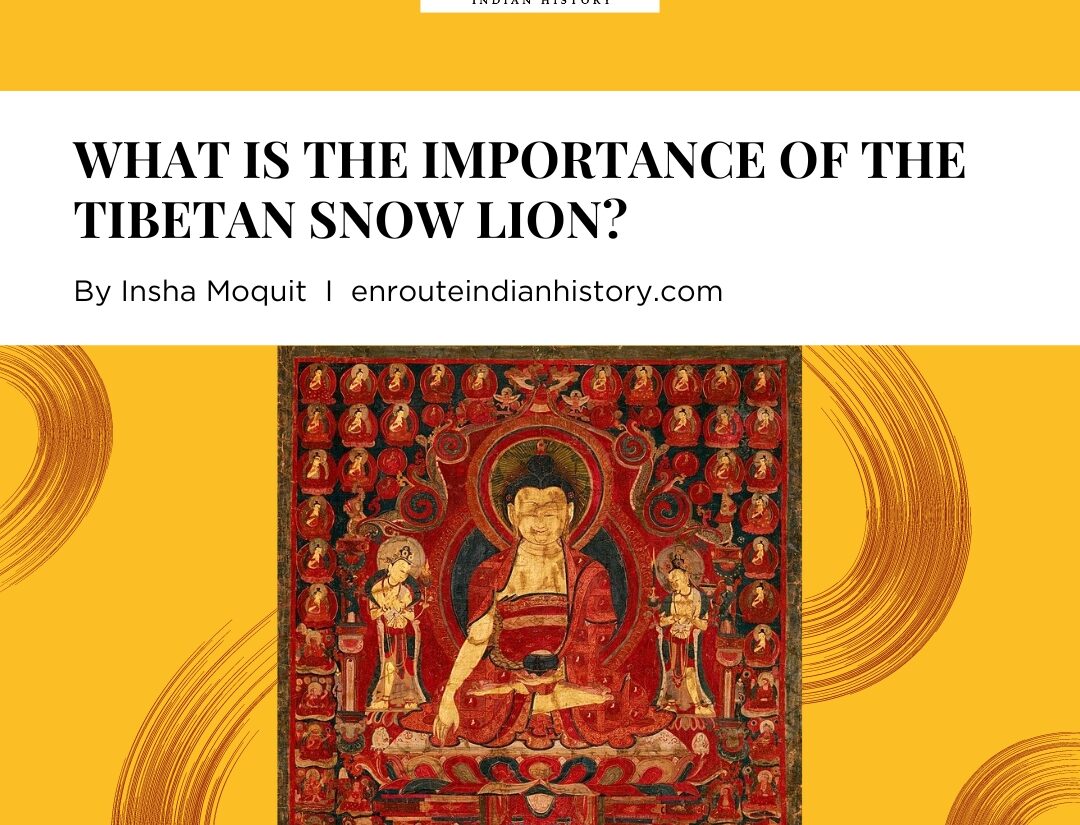
The song speaks of the mythical beast that roams above the world’s roof, where the Himalayas pierce the sky. The Tibetan snow lion, with its immaculate white coat and piercing azure eyes, personifies the wild spirit of these hallowed mountains. Its beautiful blue mane flows like wind-swept clouds against the harsh terrain. To the peoples of Tibet and Nepal, this beautiful beast is more than just an animal; it is a heavenly protector, a symbol of power and bravery in the face of nature’s harshest realm. It is their snow lion of peace.
In the snowy land of Tibet there dwells a lion,
A snow lion found in no other region.
The Supreme One is the peaceful snow lion.
Love and mercy are his turquoise mane.
Truthful speech is the lion’s roar.
Enlightened deed are the lion’s might.
This peaceful snow lion is an ornament of the world.
May this ornament gain victory over the world!
–A song by Techung, a Tibetan artist in exile
THE ORIGIN OF THE SNOW LION

The snow lion myth has its origins in ancient Tibetan scriptures and tradition, where this celestial beast has a crucial position in the Tibetan people’s cultural and spiritual identity. In Tibetan legend, it is a mythical creature who lives in the Eastern Himalayas. The term “snow lion” refers to the green-haired lion that lives in the forests and mountains surrounding the snow mountain. In the cultural traditions of Tibet, the snow lion represents strength, fearlessness, and joy, as well as Tibet’s snow-capped mountains and glaciers. The snow lion represents courage and triumph over all struggles.
Tibetans see the snow mountain lion as their mystical emblem. It is commonly described in Tibetan folk songs and proverbs as living in the highest Himalayas and guarding all aspects of the land. Tibetans regard the snow lion as a protective guardian of Tibet’s auspiciousness, and its image is extensively distributed throughout Tibetan lands, encompassing all elements of life and culture while defending the snow-covered plateau.
THE SNOW LION: POWERFUL PROTECTOR OF TIBETAN BUDDHISM
In Buddhism, the dominant religious tradition of Tibet, the snow lion holds a significant place. In early Buddhist iconography, Snow lions are frequently shown as guardians protecting the thrones of Buddhist deities such as the Shakyamuni Buddha and Buddha himself.

(An illustration from Buddhist painting showing two snow lions guarding Shakyamuni Buddha’s throne, Source: wikicommons)
In one such Tibetan Buddhist art associated with Tsaparang, Tholing and tabo monasteries, The snow lion is seen supporting the throne of Buddha Shakyamuni who points to the earth with a beseeching bowl, indicating that the earth has witnessed his waking. His patchwork robe symbolizes his non-attachment, while his golden complexion suggests his transcending nature. He is surrounded by the loving figures of the bodhisattvas Maitreya (carrying a flask) and Manjushri (a sword) while he meditates upon a radiant lotus. The sixteen arhats that encircle the lotus throne and the rows of Buddhas that occupy the upper registers symbolize Shakyamuni’s status as a cosmic Buddha.
Snow Lions are also a symbol of the wisdom, bravery, and divine pride of Buddhists, which enables them to live unhindered on the lofty mountains of the pure mind, free from illusions. The Mahayana branch of Buddhism practiced in Tibet, Vajrayana Buddhism, has guardian deities. Vaishravana is one of them, and he is sometimes shown riding a snow lion. Vaishravana is a different person, but his affiliation with the snow lion may allude to the fact that snow lions are associated with protection.
The snow lion’s roar represents the strength and truth contained in the Buddha’s teachings on liberation from karma. It was believed that a single roar could send seven dragons down from the sky. The snow lion is also seen as a symbol of protection and sovereignty in Tibetan Buddhist teachings. It reflects Tibet’s blended spiritual and secular life.
POWER AND PURITY: DECODING THE SNOW LION SYMBOL ON TIBETAN PRAYER FLAGS

(The Lungta Flag, the Tibetan prayer Flag , Source: Google Photos )
The snow lion also has its presence in The lungta, often called the Tibetan prayer flag or wind horse flag. These colorful, rectangular flags, which feature the majestic snow lion, one of the flag’s four powerful creatures, beautifully embroidered on each corner, soar in the mountain breezes of the Himalayan region. The snow lion usually takes up the upper left corner of the lungta. It is frequently shown in a vivid green hue, which stands for wind and air. These flags feature the powerful and dynamic stance of the snow lion, who is typically seen standing tall and occasionally with one paw lifted as though he is prepared to charge into action.
The snow lion is a highly significant element of the Lungta flag. It is symbolic of the traits of joy, fearlessness, and happy confidence. It stands as one of the Four Dignities in Tibetan symbolism, along with the dragon, tiger, and garuda, representing the fearless, vibrantly alive, enlightened mind and body. Furthermore, it is thought that when these flags are caught by the wind, the blessings and protective qualities of the snow lion and other revered creatures are dispersed over the region by the breeze. The lungta’s snow lion acts as a continual reminder of the fortitude and resiliency required to survive in the harsh Himalayan climate.
TIBET’S FEROCIOUS GUARDIAN: THE SNOW LION’S CULTURAL AND POLITICAL POWER

( Tibetan National Flag, Source: wikicommons)
The mythical beast is deeply ingrained in the culture of Tibetan folks. The Tibetan national flag features a significant depiction of this snow lion tale, which serves as a symbol of political authority and pride in the country. Jamyang Norbu, a writer and political activist from Tibet, believes that the snow lion is a powerful emblem of Tibetan identity and tenacity that captures the spirit of bravery and triumph linked to the nation’s past and present struggles.
Formerly a proud symbol of Tibetan autonomy, the snow lion is currently at the epicenter of a convoluted political dispute. This legendary animal graced Tibet’s coinage, stamps, banknotes, and flag from 1909 to 1959, serving as a reminder of the country’s freedom. In 1912, the 13th Dalai Lama introduced the twin snow lions, a potent national symbol derived from old military customs, which further solidified its relevance. This symbol’s significance has grown much beyond its legendary and mythical beginnings. The snow lion is still a powerful representation of the Tibetan government’s unwavering claim to sovereignty and shared secular and spiritual history for those living in exile.
The snow lion’s image is, nevertheless, severely forbidden inside Chinese boundaries; its very existence is regarded as a protest against Chinese authority. once a cultural symbol, it is now a political flashpoint due to this restriction. Displaying the snow lion has come to represent resistance, a quiet but potent declaration of cultural identity, and the aspiration for independence for Tibetans and those who support them globally. Suppressing this emblem is part of a larger Chinese government strategy to take control of Tibet’s history and identity.
The snow lion myth has significant space in Tibetan cultural traditions, in addition to being politically depicted on the flag of Tibet. The lion, which stands tall on the sides of mountains in Tibetan art, is a representation of bravery, strength, and fearlessness. It is seen by the Tibetan people as a defender and protector of their land and people, reflecting the strong spiritual bond that they have with the natural world. Moreover, the symbolism of the snow lion transcends the material world and is consistent with Tibetan spiritual traditions that value compassion, fortitude, and inner strength. This symbolism is a powerful representation of Tibetan cultural identity, spirituality, and peaceful coexistence with nature because of its complex meaning and the belief of people upholding it.
References
Chok, Tsering. “Resurgence of Literary and Cultural Nationalism in Contemporary Tibet.” The Tibet Journal, vol. 40, no. 1, 2015, pp. 81–95. JSTOR.
Goldstein, Melvyn C. The Snow Lion and the Dragon: China, Tibet, and the Dalai Lama. University of California Press, 1997.
Phuntsho, Karma. “Windhorse: In Tibet, the Wind Horse (Lungta) Is a Good Luck Charm.” National Geographic, National Geographic Society,
Tsering, Chok. “Resurgence of Literary and Cultural Nationalism in Contemporary Tibet.” The Tibet Journal, vol. 40, no. 1, 2015, pp. 81–95. JSTOR, http://www.jstor.org/stable/tibetjournal.40.1.81.
Grammarly score : 89
SEO plagiarism score : 10



















